Are you considering installing a fence around your property? Are you unsure about which types of fencing would best suit your needs? Whether you prioritise privacy, security, aesthetics, or a combination of the three, understanding the different types of fences will help you make an informed decision.
Below, I have listed the benefits, considerations, and 21 different types of fencing to make your decision easier.
More...
A Guide to Different Types of Fences
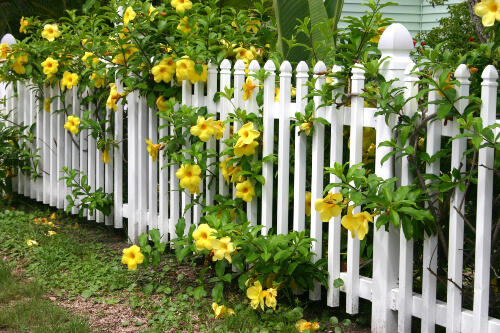
With so many different types of fences available these days, in a huge variety of materials, it can be tricky trying to narrow down and then choose the best option for your home.
Let us talk you through a selection of popular types of fences that you may be considering to complement your home.
What are the Benefits of Fencing?
Installing a fence in your outdoor space provides many benefits. Different types of fencing serve different purposes. Below are some of the benefits you can receive when you install a fence.
- Aesthetics
Fences not only serve practical purposes, but they can also enhance the visual appeal of your property. You can find different types of fencing that will complement the architectural style and add a decorative element.
- Property Lines
By clearly defining your property lines, a fence helps establish boundaries. This can minimise the risk of disputes with neighbours. It also helps to ensure that you, your family, and your pets stay within the designated area.
- Privacy
Fencing can play an important role in providing privacy and enhancing security. Different types of fencing are used to create barriers that prevent prying eyes and help prevent trespassing.
- Noise Reduction
Certain types of fencing are effective in reducing noise levels. They act as a barrier that decreases sound from nearby streets and neighbours. This can help create a more peaceful outdoor environment. They can also lessen the noise you generate from reaching your neighbours.
- Wind and Sun Protection
Fencing can act as a windbreaker and help protect your property. Solid and slatted fences can also provide shade, creating a more comfortable outdoor space.
- Safety
Fencing can be used to improve safety by acting as a boundary. It protects children and pets, preventing them from wandering away.
- Livestock Management
In agricultural settings, fences play a crucial role in containing livestock. Fencing can deter wildlife from entering.
- Increase Property Value
A high quality, well-maintained fence can add value to your property. It can make your property more appealing to potential buyers, as it offers many benefits.
Things to Consider When Choosing Fencing
When looking at different types of fencing, there are several factors to take into consideration. By carefully considering these factors, you can select the right types of fencing for your situation.


Get Your Free Guide:
Master Growing Australian Natives eBook
A Must Have Complete Guide for Every Australian Garden
Get Your Free Guide:
Master Growing Australian Natives eBook
A Must Have Complete Guide for Every Australian Garden
- Local Regulations
Check your local zoning and building codes to ensure you stay in compliance with regulations. It is essential to be aware of any restrictions and guidelines that may affect your fence installation plans.
- Purpose
What is the main purpose you want to achieve with your fence? Is it privacy, security, or aesthetics? Identifying your goal will help you select the appropriate style, design, and material.
- Style
Take into account the style of your home when looking at different types of fencing. The fence should blend in with your property and landscape. Avoid fencing that will take away from the appearance.
- Material
Different types of fencing materials have their own pros and cons. Wooden fences offer a timeless appearance and are relatively affordable. But they require regular upkeep. Metal fences are durable and low maintenance. Additional choices include vinyl, composite, bamboo, and more.
- Height
Determine the necessary height for your fence. If privacy is a priority, choose a fence that is tall enough to obstruct the view from neighbours and passersby.
- Maintenance
Consider the amount of maintenance you are willing to perform. Before installing a new fence, evaluate the upkeep. Some types of fencing need more upkeep than others.
- Budget
Establish a budget before exploring types of fencing. The cost of fencing can vary significantly. Having a clear budget in mind will help you narrow down your options.
- Climate and Environment
Consider your specific climate and environmental conditions. If you live in a coastal area, you may want to choose materials that are resistant to saltwater corrosion. In regions with extreme weather, consider a sturdy and durable fencing option.
- Security
Is security a concern? If so, consider types of fencing that are solid with locking gates.
- Longevity and Durability
How long do you need the fence to last? Research the expected lifespan and durability of different types of fencing materials. Consider factors such as weather, insects, rot, and decay.
- Wildlife
Do you live in an area with wildlife that you want to keep out? Consider fencing options that can deter or prevent animals from entering.
Types of Fences to Choose From
Fencing plays a vital role in defining boundaries, enhancing security, and adding aesthetic appeal. With numerous fencing types available, it is important to understand the different types of fencing to make your decision. Below are some popular types of fencing you may want to consider.
21 Types of Fencing
1. Tubular Fencing

Tubular fencing is made from pre-galvanised steel and is welded with stainless steel to improve its durability. This protects the fence from rust and is especially welcome in coastal areas where metal joins can be prone to becoming rusty.
You could also go for tubular aluminium fencing which is not as heavy as steel, but is also not as strong. It does however have excellent resistance to corrosion making them extremely popular in coastal areas.
2. Aluminium Woodgrain Slats

Aluminium woodgrain slats are a great alternative to real timber fencing but with the added advantage of being low maintenance. No need to regularly paint and varnish as it is treated with a timber grain finish.
You can choose from a range of timber colours as well, to ensure it perfectly complements your home. They can be installed horizontally or vertically with any size gap between the slats and come in a variety of widths, giving you even more choice.
When you choose aluminium woodgrain slats for your fence you can be assured that they will not warp, rust or rot.
3. Colorbond Fencing
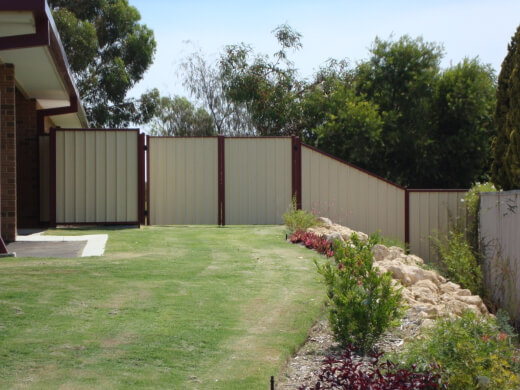
One of the most popular and recognisable fence style, Colorbond fencing is extremely durable and can be customised to include optional slats or latticing as decorative elements on your fencing.
Having your panels stepped or sloped to suit the terrain of your home is easy with Colorbond fencing and they can also be erected on limestone walls.
4. Picket Fencing

Classic in style, picket fencing is what everyone pictures when they think of period homes – while mostly chosen for their decorative style, they are also a practical choice when you opt for prefabricated steel picket fencing.
With their excellent resistance to warping and rotting, they are extremely low maintenance making them ideal for homeowners who want an elegant fence but don’t have the time to constantly repaint or revarnish.
With a wide variety of decorative tops to add to the fencing, you can really personalise the fence to your own taste and match it to the style of your home.
5. Corrugated Metal Fencing

Corrugated metal fencing is a versatile and durable option. It has a distinct aesthetic appeal for various applications. Made from galvanised steel sheets with a rippled pattern, this type of fencing offers a modern and industrial look.
Corrugated metal fencing is often used for security and privacy. Its sturdy construction makes it an excellent choice for keeping unwanted visitors out. Additionally, the fence's solid structure blocks visibility from the outside.
The durability of corrugated metal fencing makes it resistant to harsh weather conditions, such as wind, rain, and extreme temperatures. This adds to its longevity and low maintenance requirements.
6. Glass Fencing

Source: Guardian
Glass fencing is modern and elegant. It can add a touch of sophistication to your outdoor space. It is made from tempered or toughened glass panels held in place by sturdy metal posts and brackets.
The transparency of glass fencing creates an open and spacious feel. It allows for unobstructed views of the surroundings. It is a popular choice for pool areas, balconies, and terraces since it provides safety without obstructing the view.
While glass fencing is versatile and visually appealing, it is not suitable for all areas. Glass fencing should be avoided in areas with strong winds or high-impact environments, as it may be prone to breakage or damage. Additionally, if privacy is a concern, glass fencing is not the ideal choice.
7. Brick Fencing
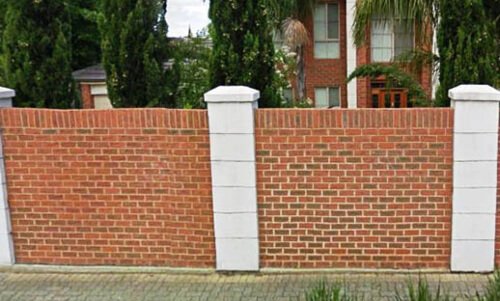
Brick fencing is a classic and timeless option. The uniformity and texture of brick fencing add a touch of elegance to both residential and commercial properties. It can be designed in various styles and sizes.
The primary uses of brick fencing are to provide security, privacy, and boundary definition. The solid construction deters trespassers and helps protect the property. Brick fencing also offers excellent noise reduction. It is a great choice for areas near busy roads or in densely populated neighbourhoods.
Brick fencing is durable and low maintenance. It is a long-lasting option that requires minimal upkeep. While brick fencing is a great choice in many situations, it should be avoided in areas with unstable soil conditions. The movement of the ground can cause the brickwork to crack or shift.
8. Stone Fencing
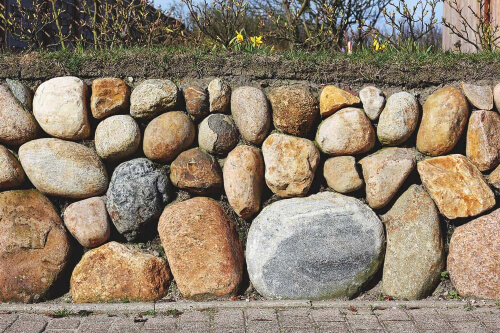
Stone fencing creates a rustic and natural charm. It is constructed using various types of stone, such as limestone, granite, or fieldstone, arranged in a stacked design. Depending on the wall, the stones can be mortared in place.
The textures of the stone and the earthy colours create a visually striking appearance. This makes it an attractive choice for both residential and commercial properties.
Stone fencing can be used for multiple purposes. These include security, privacy, and boundary definition. Stone fencing provides excellent noise reduction, which makes it ideal for noisy environments. The natural beauty enhances privacy while creating a secluded and tranquil space.
Stone fencing is a long-lasting option that requires little maintenance. However, it is not suitable for areas with unstable soil conditions. The movement of the ground can cause the stonework to shift or crack.
9. Composite Fencing
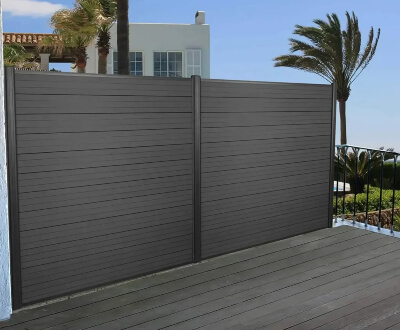
Composite fencing is a modern and eco-friendly option. It combines the benefits of both natural wood and synthetic materials. The material is a durable and low-maintenance fencing solution. Composite fencing offers a clean and contemporary look. The fencing can complement a variety of architectural styles.
The versatility of the fencing makes it suitable for various uses in both residential and commercial settings. Composite fencing comes in various styles that can be used for privacy and decorative purposes. It is available in a wide range of colours and finishes.
Composite fencing is resistant to warping, cracking, and splintering. It is a wonderful choice for areas with high moisture or harsh weather conditions. The material requires minimal maintenance, eliminating the need for staining, sealing, or painting. Composite fencing may not be suitable for high-temperature environments. The fencing can expand in extreme heat.
10. Wire Mesh Fencing
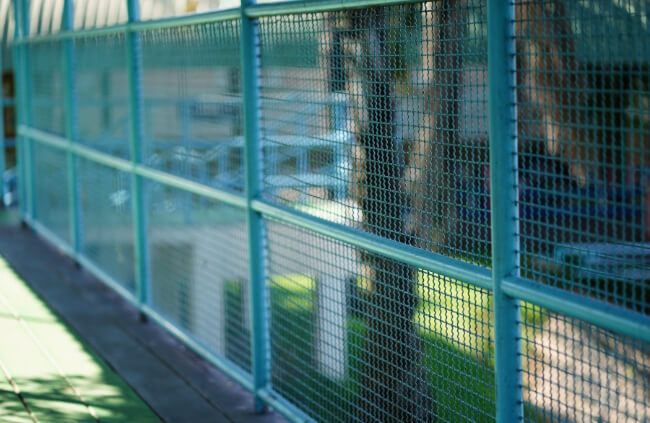
Wire mesh fencing is a practical solution for various situations. It consists of interwoven or welded metal wires, typically made of steel, forming a grid pattern. Wire mesh fencing comes in different gauges and mesh sizes. This allows for customisation based on your specific needs.
One of the main uses of wire mesh fencing is for containment purposes. Its sturdy construction provides a strong barrier. Wire mesh fencing is commonly used for creating animal enclosures. It is suitable for areas where monitoring is necessary.
While wire mesh fencing is highly versatile, there are certain instances where it may not be ideal. The fencing is prone to corrosion and rust, especially in coastal regions. You can find wire mesh fencing made from corrosion-resistant materials, or you can treat the fence to prevent damage.
11. Stockade Fencing
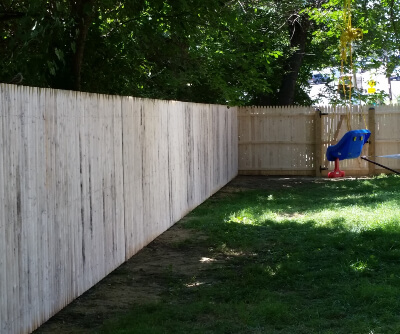
Source: Frederick Fence
Wooden stockade fencing is a popular choice for both residential and commercial properties. It has a classic and timeless appearance. This type of fencing is constructed of closely spaced vertical pickets that are attached to horizontal rails.
The construction creates a solid and sturdy barrier. The height of the fence can vary depending on your specific needs and preferences. Wooden stockade fencing offers several benefits. It provides a high level of privacy, it has a solid construction, deters trespassers, and serves as a windbreaker.
There are certain situations where wooden stockade fencing is not suitable. Wood is a natural material that requires regular maintenance to prevent rotting, warping, and other damage. Therefore, in areas with high humidity, wooden stockade fencing may not be the appropriate choice.
12. Shadowbox Fencing
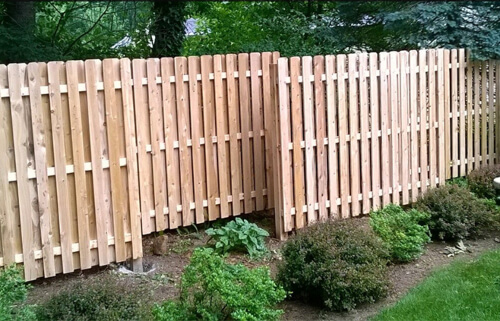
Shadowbox fencing combines privacy with an attractive appearance. It features overlapping vertical wooden boards on both sides of the fence. The placement of the boards creates a shadowbox effect. This type of fence allows air and some light to pass through, while offering a certain level of privacy.
The main reason to use shadowbox fencing is to create a visually pleasing boundary while maintaining some privacy. It makes an excellent choice for backyard enclosures and outdoor living spaces. The fencing can also help reduce noise and create a sense of security without completely isolating the property.
Shadowbox fencing is not suitable for locations where complete privacy is needed. It is also important to note that shadowbox fencing requires regular maintenance to protect it from weathering and decay.
13. Bamboo Fencing
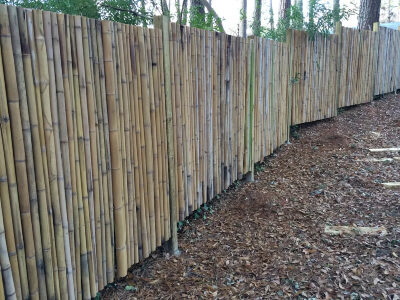
Bamboo fencing is a unique and eco-friendly option. It offers a natural and exotic appearance. The fencing is made from bamboo poles that are woven together and secured. Bamboo can create a sturdy and visually appealing fence.
Bamboo fencing is often used for privacy and decorative purposes. It provides a natural barrier that offers partial visibility while maintaining a sense of privacy. It can also be used for climbing plants.
Bamboo fencing is known for its sustainability and durability. It is not suitable for areas with high humidity or excessive moisture, since bamboo is susceptible to rot and decay. Additionally, bamboo fencing does not provide the same level of security as other types of fencing.
14. Split Rail Fencing
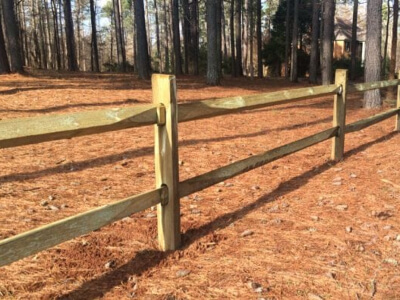
Split rail fencing is a rustic and traditional option that is visually appealing look. It is constructed using wooden posts and horizontally placed split rails. This type of fencing complements various landscapes, such as rural and country farmhouse settings. The open design of the fence allows for an unobstructed feel, making it an ideal choice for decorative purposes.
The primary use of split rail fencing is to mark boundaries and define property lines. It is commonly used in agricultural settings, farms, and rural areas. Additionally, it can be used in landscaping projects to separate different sections of a garden.
Split rail fencing is not a suitable choice for locations that require high levels of security or privacy. It is also important to note that split rail fencing cannot withstand heavy impacts or provide as much stability.
15. Wrought Iron Fencing

Wrought iron fencing is a classic and elegant option. It will add a touch of sophistication and timeless beauty to any property. The fencing is crafted from iron that is heated, bent, and shaped into intricate designs and patterns. Wrought iron fencing can enhance both residential and commercial settings.
Wrought iron fencing is commonly installed for security, boundary definition, and aesthetic purposes. Wrought iron fencing is strong and durable. It offers security while maintaining an open view.
While wrought iron fencing is highly durable, it is not suitable for uneven terrains or locations with poor soil conditions. The fencing requires proper anchoring and stability. Additionally, wrought iron fencing may require regular maintenance to prevent rust or corrosion.
16. Vinyl Fencing
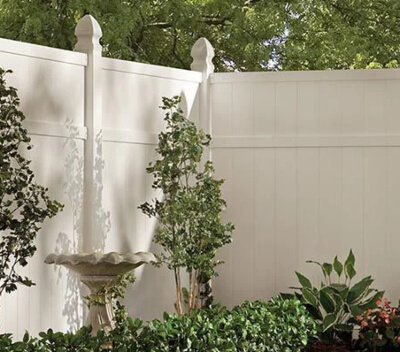
Vinyl fencing is a popular option that has a clean and polished look. It is made from a durable, weather-resistant plastic material. Vinyl fencing is available in a wide range of styles and colours. The smooth surface of vinyl fencing creates a sleek and modern aesthetic.
The uses of vinyl fencing are diverse. It is commonly installed for privacy, security, and decorative purposes. Vinyl fencing can offer excellent privacy, as it is available in different heights and can be installed without any gaps.
Vinyl fencing requires minimal maintenance, as it is resistant to rot, warping, and pests. While vinyl fencing is popular, it is not suitable in areas with extreme temperature fluctuations or excessive winds.
17. Chain Link Fencing
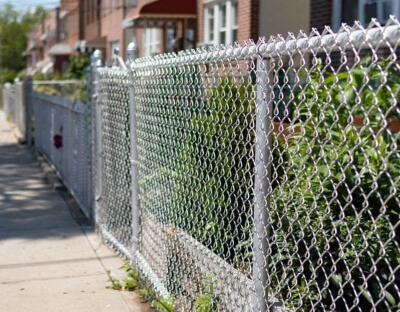
Chain link fencing is a practical option. It consists of galvanised steel wires that form a diamond-shaped pattern. The transparency of chain link fencing allows for unobstructed views both inside and outside the enclosed area. This makes it suitable for areas where visibility is desired.
Chain link fencing is commonly used for residential, commercial, and industrial settings. Its distinctive look provides a simple yet effective solution for security, containment, and boundary purposes.
While chain link fencing is low maintenance and affordable, there are a few things to keep in mind. Chain link fencing is not a good choice for creating privacy. Chain link fencing can also be easily climbed and cut through.
18. Ornamental Steel Fencing

Ornamental steel fencing is a stylish and sophisticated option. It is durable and decorative. The fencing is crafted from high-quality steel which is both strong and aesthetically appealing.
It is commonly used for both security and decorative purposes. Ornamental steel fencing provides a strong and secure barrier. It can be used to secure residential properties, commercial buildings, parks, and public spaces. It is often chosen when trying to create an upscale look.
While ornamental steel fencing offers many advantages, it can be damaged by humidity and saltwater exposure. Depending on your location, it may require regular maintenance.
19. Horizontal Slat Fencing
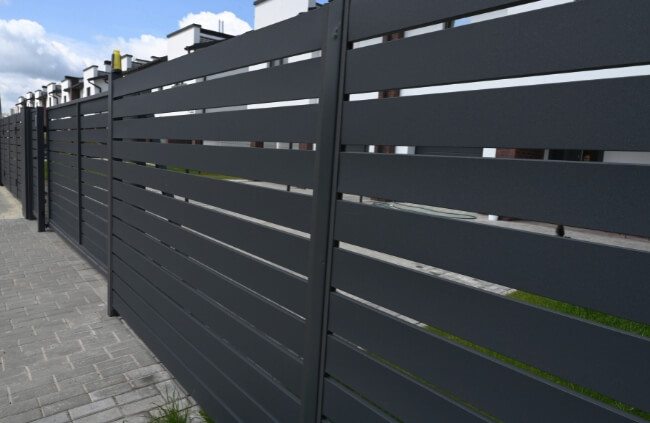
Horizontal slat fencing is a contemporary, sleek option that can be used to create a modern look. It features horizontal boards that are evenly spaced, creating a visually striking pattern. Horizontal slat fencing is available in a variety of materials, such as wood, composite, and metal.
Horizontal slat fencing is commonly used to create privacy and boundary definition. The evenly spaced slats offer a level of privacy by partially obstructing the view from the outside. It is often used to enclose backyard areas, patios, or pool surroundings.
In areas with high wind loads, horizontal slat fencing may not be the best option. The wind can potentially put stress on the structure, causing it to fail. Additionally, the fencing may require regular maintenance depending on the material you choose.
20. Masonry Fencing
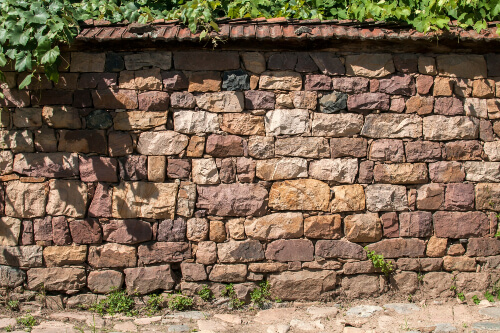
Masonry fencing is a strong and durable option. It is constructed with concrete blocks, which are arranged to create a solid barrier. It can be customised to complement various styles, whether modern, traditional, or rustic.
The main uses of masonry fencing are security and privacy. Due to its sturdy nature, it serves as an effective deterrent to unauthorised access. The solid blocks also create a sense of seclusion.
Masonry fencing is highly durable and requires minimal maintenance. It is a long-lasting option that can withstand harsh weather conditions. The fencing can also help reduce noise and create a quieter and more peaceful environment. Masonry fencing is not recommended in areas with unstable soil conditions.
21. Brushwood Fencing

Source: Insteading
Brushwood fencing is a natural and eco-friendly option. It provides a rustic and charming appearance to outdoor spaces. The fencing is crafted brushwood that is interwoven between vertical support posts. The fence has a textured and organic look, that can easily blend into natural surroundings.
The main uses of brushwood fencing are to create privacy and provide a windbreak. The dense construction of the fence can block the view from outside. It also acts as a barrier to wind, creating a more sheltered and relaxing outdoor space.
While brushwood fencing has its advantages, it may not be suitable for areas with high humidity or heavy rainfall. Since the fence is made from organic materials, it can be prone to rot and mould if not properly maintained. It is also important to note that brushwood fencing does not provide a high level of security.
Take these types into consideration when you are planning your home or granny flat.
Do you want more fencing ideas but on a budget? Check out our bamboo screening guide and product reviews on the best bamboo screens available online.
Wrapping Up Our Types of Fences Guide
When choosing the right types of fencing, it is crucial to consider important factors. The ideal fencing types for your property depend on your specific needs, preferences, and your property. By carefully considering these factors, you can choose between the types of fencing that best suits your needs.
The type of fencing you choose not only affects the aesthetics of your home and it's security. Keep in mind you also need to choose the right one best fitted on your weather.
So if your area tends to get heavy rain or storms, it is essential to take that into consideration.
There you have it, time to choose which of these types of fences fit your style.
Published on July 24, 2023 by Jim Horton
Last Updated on September 19, 2024



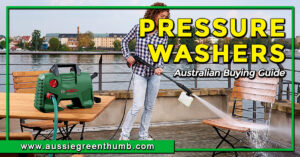
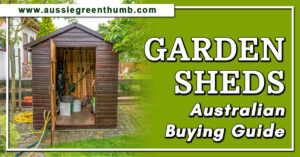
Cherie Boucher liked this on Facebook.
Annabel Hartridge liked this on Facebook.
Annabel Hartridge liked this on Facebook.
Cherie Guest liked this on Facebook.
I want to make sure that Ig et the right fencing for my home. It makes sense that I would want to consider something like tubular fencing for my home! It's nice that it can be so sturdy and durable. That way, I don't need to worry about replacing it any time soon.
I like that you talked about how practical picket fencing is. As you said, they can resist warping and rot which is why they are low maintenance. I hope that I can find a fence company that can install this for our home since I am on a limited budget. We just need fencing because we have a dog now, and it would keep it from running to the road.
With its interlocking steel wires, chain link fences provide an extremely strong barrier to protect your home or business. If you're after a high enclosure that discourages climbing, you can adapt its height for your needs.